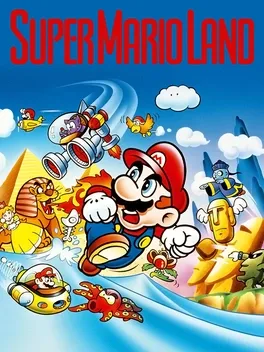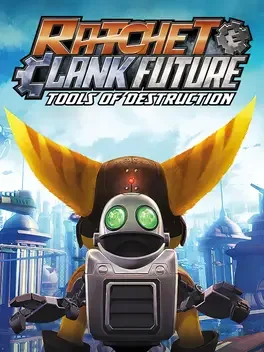(Originally published to Glitchwave on 1/2/2025)
[Image from igdb.com]
Super Mario Land
Developer: Nintendo
Publisher: Nintendo
Genre(s): 2D Platformer
Platforms: Gameboy
Release Date: April 21, 1989
The one inherent downgraded aspect of Super Mario Land is the visuals. The original Game Boy subtracted three-fourths of the NES’ 8-bits to a meager two, which resulted in tarring the primitive pixels in a murky haze of black and white like the earliest of films. Given that every game released on the Game Boy couldn’t ascend over the minimal presentation, factoring it into the quality of Super Mario Land is a moot point. What concerns me is how Mario’s simplistic running and jumping-intensive gameplay translates from Super Mario Bros., and it’s practically identical. However, I still wouldn’t call the successful translation commendable as it carries the same issues that were present in Mario’s older console debut. Mario’s acrobatics are heavily subdued by the rigid controls. Oftentimes, the only way to accurately land Mario on a platform is to mash the directional pad (even though I’m admittedly not playing this game on an original Game Boy) like flattening hard Play-Doh and even then, the result of what was intended isn’t guaranteed to be in your favor. While this is obviously an objective flaw, it’s a “sins of the father” scenario and my stance in evaluating Super Mario Land is how it stacks up with its console cousin. With this in mind, there is no significant decline. Still, the developers desperately need to apply oil to the control scheme for future entries.
While this review includes constant comparisons to Super Mario Bros., Super Mario Land is directed like a spinoff of the core Super Mario titles on the NES. In the nature of a spinoff, Super Mario Land features plenty of stark deviations from the regular course of Super Mario Bros. properties. For one, the setting isn’t the standard stomping grounds of the Mushroom Kingdom. Super Mario Land transports our hero to the kingdom of Sarasaland, a desert realm with pronounced Egyptian iconography. The torrid, sandy environment allows for an entirely different ecosystem of enemies than that of the green, hilly Mushroom Kingdom–including fire-spitting rattlesnakes and sentient miniature versions of The Great Sphinx. The hostile Easter Island heads may throw off the enemy theme’s cohesion, but when is the mainline Mario series ever going to insert something this kooky into the mix of standard enemies? Sarasaland also sees plenty of Mario enemy standbys roaming around like the goombas, koopas, and bullet bills to retain the series’ identity, but the foreign location still alters some attributes of the familiar foes. When a Koopa Troopa exploded after Mario had stomped on it, it certainly caught me off guard. The princess whom Mario excavates a dozen incorrect castles trying to save isn’t the blonde bimbo with the pink dress. Instead, it’s her spunkier brunette counterpart Daisy situated in the damsel in distress position before she solidified a position in the series as Peach’s permanent sporting event partner. On another note, it is so fitting for Luigi that his (non-canonical) girlfriend is simply Mario’s sloppy seconds. Rescuing Sarasaland’s royal highness will have Mario climbing between the dunes on the surface and the ancient crypts underneath, exhibiting the same dichotomy as the overworld and the sewers in his home city. Between platforming through dirt and sand, Super Mario Land incorporates something wild that the series hasn’t dabbled with since. Mario will either fly a biplane or steer a submarine and use their respective projectiles in an auto-scrolling space shooter segment a la Gradius. Not only is the gameplay shift a nice change of pace, but the image of tiny little Mario piloting these military vehicles is adorable. With all of the diversity that Super Mario Land displays, it’s a wonder why Nintendo felt the need to plagiarize another game’s properties to make the American Super Mario Bros. 2 different from the first one.
The biggest surprise I never expected from Super Mario Land is how accommodating the game is, a gameplay attribute that it certainly did not pick up from any Mario game on the NES. Considering that Super Mario Land acts as a primitive version of a game already synonymous with the growing pains of gaming’s history, I fully expected the developers to bombard the player with a merciless streak of challenging obstacles and harsh penalties. To my surprise, Super Mario Land was as sweet and smooth as a strawberry daiquiri. Platforming has its deadly hazards, but is always clear and fair to the player. Enemies are placed modestly around and are manageable to either confront or evade. Even with reasonable obstacles to handle, the game obliges the player with plenty of aid to keep them on their feet. Climbing the top section of the tower at the end of each level is guaranteed to net the player some reward, even if they can’t time the flashing ladder to the position of their liking. Stacking up a whole inventory of lives is one thing, but something accommodating that floored me with its inclusion is a continue system. If the player earns enough points on the field, the game will recognize their achievement and compensate them by respawning Mario at the beginning of the world. I never had to expend my points because the influx of lives kept me afloat, but I’m delighted that this safety net exists on principle. One would think that the game would be especially arduous due to its short length, but the developers decided to treat the experience like a rollercoaster: a brief, yet joyous ride that will ideally warrant another trip around.
Despite the reputation handheld games have garnered, Super Mario Land is definitely not a digression from Super Mario Bros.. Looking past the monochromatic restrictions of the visuals, every other aspect of the game showcases an evolution for the series. It wisely deviates from the arcade difficulty penalties that plagued the Super Mario games on the NES, and there’s far more fresh gameplay and foreground features than what is usually found in modern Mario titles. The game is afflicted by horribly stiff controls like its older Mario brethren, which is still inexcusable. All the same, is it a bold statement to say that Super Mario Land is BETTER than the high-end console counterpart? No, because it should be readily apparent to everyone.




No comments:
Post a Comment